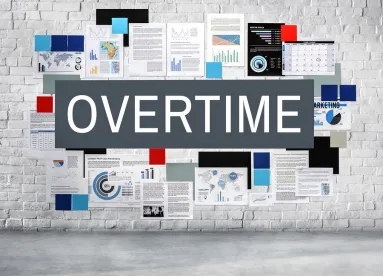The Oregon Bureau of Labor and Industries (BOLI) has made an important change to its interpretation of the relationship between two Oregon overtime laws. Under BOLI’s new guidance, nonexempt employees who work in mills, factories, or manufacturing establishments may be entitled to both daily and weekly overtime compensation.
Most employers are familiar with Oregon Revised Statutes (ORS) 653.261, which provides that employees who work over 40 hours in one week must be paid at a weekly overtime rate of one-and-one-half times their regular hourly rate. A separate statute, ORS 652.020, provides that certain employees who work in a mill, factory, or “manufacturing establishment” for more than 10 hours in one day must be paid at a daily overtime rate of one-and-one-half times their regular hourly rate. According to that law, a “manufacturing establishment” is any place where machinery is used for manufacturing purposes, including making goods from raw or prepared materials.
In construing the two overtime statutes, BOLI’s Technical Assistance for Employers Program (TA) had historically advised manufacturers that “when employees who are entitled to daily overtime have worked more than 40 hours in the workweek and have also exceeded the maximum number of hours on one or more days, thereby earning daily overtime, the employer should calculate overtime hours worked on both the daily and weekly bases and pay the greater amount.” However, in December 2016, BOLI quietly changed its interpretation in response to a pending class action lawsuit against a Portland bakery in which employees seek both daily and weekly overtime compensation. In that lawsuit, the Commissioner of BOLI, Brad Avakian, provided a declaration stating that the class action lawsuit had “prompted BOLI to take a closer look” at its past interpretation. Commissioner Avakian explained that the state Wage and Hour Division now believed that the laws requiring daily and weekly overtime “operate independently of one another and, as such, there is no basis for offsetting the overtime wages earned pursuant to one of the state’s overtime provisions against the other in those cases where an employee has earned both daily and weekly overtime.”
BOLI’s new interpretation is now reflected in its updated Field Operations Manual, which provides, in part: “[I]t is the Wage and Hour Division’s position that employers, when determining the amount of overtime earned by an employee who, during a work week, has worked more than 10 hours per day in a manufacturing establishment and more than 40 hours in the week, must calculate the amount of overtime earned by the employee under each regulation and pay both overtime amounts to the employee.” Further updated guidance is available on BOLI’s website.
Exemptions
Not every manufacturing employee is impacted by this interpretive change. The law imposing daily overtime requirements, ORS 652.020, does not apply to union employees where a collective bargaining agreement establishes different limits on the required hours of work and the payment of overtime. There are also limited exemptions from the daily overtime requirement based on employee duties. For example, under OAR 839-001-0125, manufacturers are not required to pay daily overtime to any employee whose primary duty is that of supervising and directing work, such as supervisors, managers, foremen/women, and persons who are temporarily acting in these capacities. Lastly, employees of certain manufacturing establishments in the timber industry—sawmills, planing mills, shingle mills, and logging camps—remain exempt under ORS 652.030 until daily overtime requirements are imposed in all of the surrounding states of California, Washington, and Idaho.
Compliance Concerns
For many manufacturers, compliance with BOLI’s new rule interpretation will have a significant impact. Manufacturers must alter practices to comply with the new interpretation or risk exposure to overtime wage claims. Associated Oregon Industries (AOI) is leading an effort to introduce a bill in the 2017 legislative session that would require manufacturers to adhere to BOLI’s former interpretation of the overtime laws. However, employers should not count on a potential legislative fix that, if successful, would not take effect for at least another six months. Employers that are potentially subject to BOLI’s new interpretation should take action now to carefully review their shift lengths and overtime pay practices to determine what steps are needed to comply.





 />i
/>i

